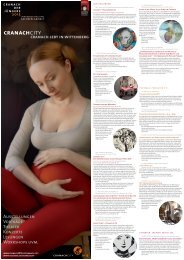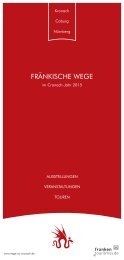In the Footsteps of Cranach - A Journey of Discovery
Twelve German towns and cities have come together in the 'Routes to Cranach' project to bring the life and works of the renowned Renaissance artist Lucas Cranach to the widest audience.
Twelve German towns and cities have come together in the 'Routes to Cranach' project to bring the life and works of the renowned Renaissance artist Lucas Cranach to the widest audience.
You also want an ePaper? Increase the reach of your titles
YUMPU automatically turns print PDFs into web optimized ePapers that Google loves.
Tracing <strong>the</strong> history <strong>of</strong> <strong>the</strong> famous family <strong>of</strong> painters<br />
Alongside Albrecht Dürer (1471–1528), Lucas<br />
<strong>Cranach</strong> <strong>the</strong> Elder (1472–1553) is regarded as <strong>the</strong> most in -<br />
fluential artist <strong>of</strong> <strong>the</strong> German Renaissance. His paintings<br />
can be admired in countless museums; <strong>the</strong>y enjoy critical<br />
acclaim in major exhibitions and are subject to reinterpretation<br />
by art historians time and time again.<br />
But where did this prolific painter come from, a man<br />
who – unlike almost any <strong>of</strong> his contemporaries – conducted<br />
business like an artist <strong>of</strong> <strong>the</strong> modern age? Where are <strong>the</strong><br />
places most closely associated with his life, and what can we<br />
learn <strong>the</strong>re about him, his family, his work, his patrons and<br />
his legacy?<br />
Embark on a journey <strong>of</strong> discovery in <strong>the</strong> footsteps <strong>of</strong><br />
<strong>Cranach</strong>. Retrace <strong>the</strong> path <strong>of</strong> a painter, who not only captured<br />
<strong>the</strong> major <strong>the</strong>mes <strong>of</strong> his day in important works <strong>of</strong> art,<br />
but was also a friend <strong>of</strong> Martin Lu<strong>the</strong>r and supporter <strong>of</strong> <strong>the</strong><br />
Reformation, and part <strong>of</strong> an era <strong>of</strong> radical change on <strong>the</strong> way<br />
to <strong>the</strong> modern world. Discover Kronach, his place <strong>of</strong> birth,<br />
and visit Wittenberg, where he lived and worked as a court<br />
painter to <strong>the</strong> Electors <strong>of</strong> Saxony from 1505, and where his<br />
son Lucas <strong>Cranach</strong> <strong>the</strong> Younger (1515–1586) continued to run<br />
his workshop from 1550. The only known mural by <strong>Cranach</strong><br />
can be seen in Hartenfels Palace in Torgau. He spent his final<br />
years living in Weimar, where he is also buried. You will also<br />
discover o<strong>the</strong>r sites and treasures associated with <strong>the</strong> great<br />
painter in Nuremberg, Coburg, Dessau, Erfurt, Gotha, Neustadt<br />
an der Orla, Schneeberg and Meissen, and at Wartburg<br />
Castle in Eisenach. Admire <strong>the</strong> <strong>Cranach</strong> altar at St John’s<br />
Church in Neustadt an der Orla, a religious work <strong>of</strong> art that<br />
still stands in its original location, and compare it with <strong>the</strong>







